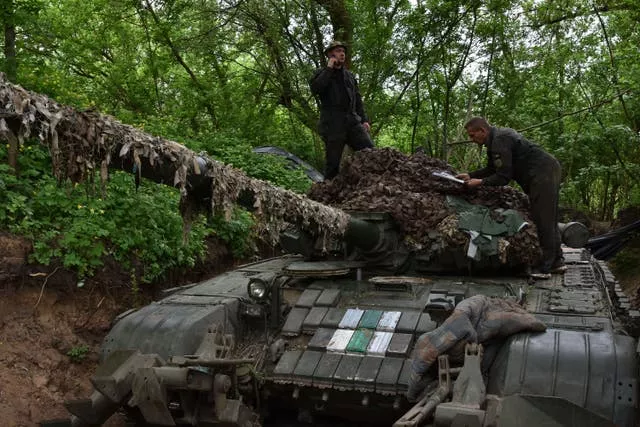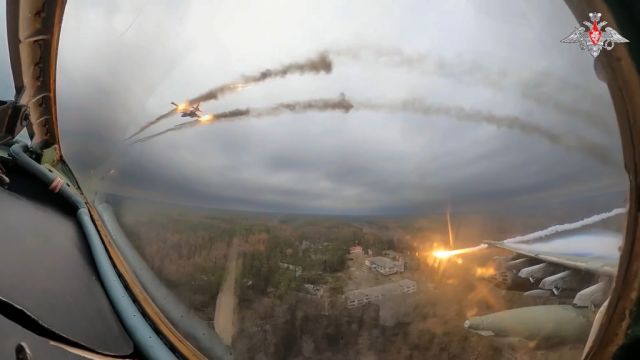Russian troops are ramping up the pressure on exhausted Ukrainian forces ahead of a bid to seize more land this spring and summer as muddy fields dry out, allowing tanks, armoured vehicles and other heavy equipment to roll into key positions.
With the war in Ukraine now in its third year and a vital American aid package for Kyiv slowed down in US congress, Russia has increasingly used satellite-guided gliding bombs – which allow planes to drop them from a safe distance – to pummel Ukrainian forces beset by a shortage of troops and ammunition.
Despite Moscow’s advantage in firepower and personnel, a massive ground offensive would be risky and, according to Russian military bloggers other experts, unnecessary, if Russia can stick to smaller attacks across the front line to further drain the Ukrainian military.

Michael Kofman, a military expert with the Carnegie Endowment, said in a recent podcast: “It’s potentially a slippery slope where you get like a death by a thousand cuts or essentially death by a thousand localised offensives.”
If the Russians stick to their multiple pushes across the front, he said, “eventually they may find more and more open terrain”.
Last summer’s counter-offensive by Ukraine was doomed when advancing Ukrainian units got trapped on vast Russian minefields and massacred by artillery and drones. The Russians have no reason to make that same mistake.
Last November, Ukrainian President Volodymyr Zelensky ordered his forces to build trenches, fortifications and bunkers behind the more than 620-mile front line, but analysts say construction work moved slowly, leaving areas unprotected.
👉Find out about Russia's invasion of Ukraine and the impact it’s had on the lives of Ukrainian citizens and recruits in our new documentary.
Catch ‘Britain x Ukraine | Access All Areas On Operation INTERFLEX’ on MOD YouTube Now https://t.co/PePNAKMjac
🇺🇦#SlavaUkraini🇺🇦 pic.twitter.com/s3AjzOjfHn— Ministry of Defence 🇬🇧 (@DefenceHQ) April 18, 2024
Ukrainian military expert Oleh Zhdanov said: “If the defensive lines had been built in advance, the Ukrainians wouldn’t have retreated in such a way.
“We should have been digging trenches through the (autumn) and it would have stemmed Russian advances. Now everything is exposed, making it very dangerous.”
In a recent podcast, Mr Kofman also said that Kyiv is “quite behind on effectively entrenching across the front” and “Ukraine does not have good secondary lines”.
After capturing the Ukrainian stronghold of Avdiivka, Russian troops are zeroing in on the hill town of Chasiv Yar, which would allow them to move towards Sloviansk and Kramatorsk, key cities in the Kyiv-controlled part of the Donetsk region in eastern Ukraine.
Russia illegally annexed Donetsk and three other regions in 2022, and the Kremlin sees fully controlling that region as a priority.
Rescue operations are underway in Dnipro following a Russian strike. Several floors of a typical residential building were destroyed, and the railway station sustained damage.
Kryvyi Rih and Synelnykove in the Dnipropetrovsk region were also targeted. All injured people are… pic.twitter.com/t0zX4TwJhY— Volodymyr Zelenskyy / Володимир Зеленський (@ZelenskyyUa) April 19, 2024
Mr Zhdanov said Ukraine does not have the firepower to repel Russian attacks.
“They promised to have a defensive line six miles behind Avdiivka where our troops could get and dig in, but there is none,” he said.
Gen Christopher Cavoli, head of US European Command, sounded the alarm before US congress last week, warning that Ukraine will be outgunned 10 to one by Russia in a matter of weeks if members do not approve more military aid.
After securing another term in a preordained election in March, President Vladimir Putin vowed to carve out a “sanitary zone” to protect Russia’s border regions from Ukrainian shelling and incursions.
Mr Putin did not give any specifics, but Russian military bloggers and security analysts said that along with a slow push across the Donetsk region, Moscow could also try to capture Ukraine’s second-largest city of Kharkiv, which Russia tried and failed to take in the opening days of the war.
In a possible sign of a looming attack on Kharkiv, a city of 1.1 million about 20 miles south of the border, Russia has ramped up strikes on power plants in the area, inflicting significant damage and causing blackouts.
Ukraine does not have enough air defence to protect Kharkiv and other cities, and the constant Russian strikes are part of Moscow’s strategy to “suffocate” it by destroying its infrastructure and forcing its residents to leave, Mr Zhdanov said.

Meanwhile, Ukraine’s air force claimed it shot down a Russian strategic bomber, but Moscow officials said the plane crashed in a sparsely populated area due to a malfunction after a combat mission.
Neither claim could be independently verified. Previous Ukrainian claims of shooting down Russian warplanes during their more than two-year war have met with silence or denials from Moscow.
Russia’s air force is vastly more powerful than Ukraine’s, but sophisticated missile systems provided by Kyiv’s Western partners are a major threat to Russian aviation.
The Ukrainian report said the air force and military intelligence cooperated to bring down the Tu-22M3 bomber with anti-aircraft missiles. Russia commonly uses the bomber to fire Kh-22 cruise missiles at Ukrainian targets from inside its own airspace. The plane can also carry nuclear warheads.
The Russian defence ministry said the warplane crashed “in a deserted area” in Russia’s southern region of Stavropol.
Three crewmembers were rescued after ejecting from the aircraft, and the search for a fourth is taking place, according to the ministry. But Stavropol governor Vladimir Vladimirov said one of the rescued pilots died.
Elsewhere, Russian missiles struck cities in the central Dnipro region of Ukraine, killing eight people, including an eight-year-old girl, and injuring 25, local officials said.
Russian forces conducted a combined aerial attack with the use of 22 missiles of various types and 14 Shahed drones during the night, the Ukrainian air force said.
All fourteen Shahed drones and 15 of the missiles were intercepted, according to the military officials.







